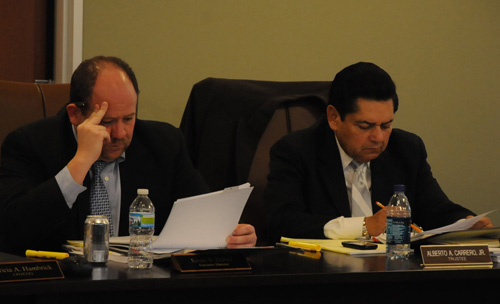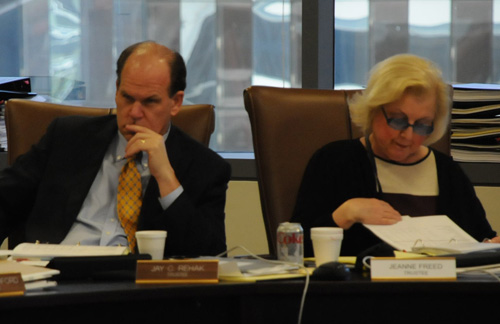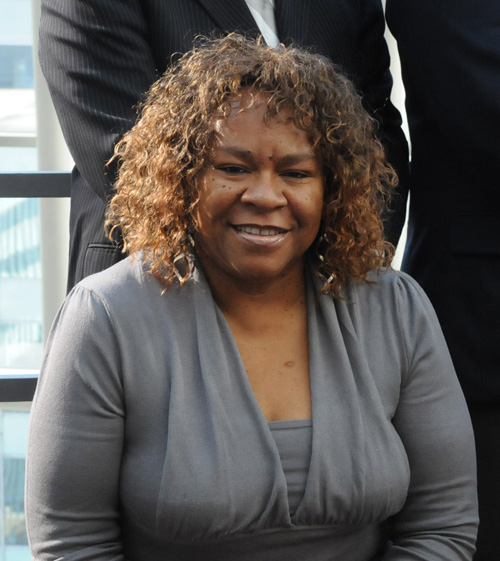Teacher Pension Fund Looking More International as international and 'emerging markets' get riskier
The Chicago Teachers Pension Fund is looking to increase its stake in international markets from 22% to 31%, or $857 million. This raised the eyebrows of Alberto Carrero, a pension trustee who is also a member of the Chicago Board of Education.
 CTPF Executive Director Kevin Huber (above left) studies materials provided to the trustees along with Alberto Carrero Jr., who represents the Chicago Board of Education. The above photo was taken at the CTPF's November 2010 meeting. Substance photo by George N. Schmidt.“I look at the international markets everyday and I don’t like it,” Carrero told CTPF staff at the monthly pension board meeting on April 14 at 203 N. La Salle St. “It’s not a bright future.”
CTPF Executive Director Kevin Huber (above left) studies materials provided to the trustees along with Alberto Carrero Jr., who represents the Chicago Board of Education. The above photo was taken at the CTPF's November 2010 meeting. Substance photo by George N. Schmidt.“I look at the international markets everyday and I don’t like it,” Carrero told CTPF staff at the monthly pension board meeting on April 14 at 203 N. La Salle St. “It’s not a bright future.”
The forecast for international markets is similar to domestic markets, but this decision is more about diversifying risk in both markets, versus just focusing on returns, the CTPF said.
According to the CTPF, 77 percent of the $857 million will be in developed countries, while 23% will be in emerging markets. Fewer managers will handle the international accounts in comparison to the domestic markets, CTPF director Kevin Huber told the board.
The Board then heard reports from a few money managers.
The $480 million pension fund money that Morgan Stanley currently oversees has seen an annual return of 9.69%, better than the 5.38% benchmark return, representatives from the fund stated at the meeting. The CTPF originally invested $158 million with Morgan Stanley in 1995.
Morgan Stanley has $18.2 billion in managed assets and feels bullish about the insurance sector because it does not have the regulation or funding risks that the banking sector has, Morgan Stanley said.
 Jay Rehak and Jeanne Freed (above left and right) are two of the six trustees representing teachers. The above photo was taken at the CTPF's November 2010 meeting. Substance photo by George N. Schmidt.Trustee Jay Rehak asked Morgan why they had so much money in Japan, noting that one portfolio manager pulled their money out of the country that has been devastated by earthquakes and a tsunami.
Jay Rehak and Jeanne Freed (above left and right) are two of the six trustees representing teachers. The above photo was taken at the CTPF's November 2010 meeting. Substance photo by George N. Schmidt.Trustee Jay Rehak asked Morgan why they had so much money in Japan, noting that one portfolio manager pulled their money out of the country that has been devastated by earthquakes and a tsunami.
“Some children were thrown out with the bath water,” said the Morgan Stanley rep based in Singapore, who said they still believe Japan is a quality investment.
One money manager said the developed world (Europe, US) are overleveraged (too much borrowing), while the developing world (Brazil, India, etc.) are at risk of ‘overheating’ (inflation) and subject to political pressures and “populist measures.”
“The political risk is the biggest problem for us,” Morgan Stanley said. “The political risk has never been (this) high since World War II.”
The next money manager to present at the Board meeting was Lazard with whom the CTPF invested $250 million in 2000 with an annual rate of return of 6.3%, over the standard 5.7%, Lazard stated.
Lazard had its worse years when the stock market soared between 2003 and 2009, but did well during the economic free fall in 2008 when the country’s major banks had to be bailed out by the US government, Lazard said.
 Teacher trustee Lois Ashford (above) was first elected in October 2009. The above photo was taken at the CTPF's November 2010 meeting. Substance photo by George N. Schmidt.The fund has not done well when the markets are up 30 percent, Lazard said, but does do well when markets are sluggish.
Teacher trustee Lois Ashford (above) was first elected in October 2009. The above photo was taken at the CTPF's November 2010 meeting. Substance photo by George N. Schmidt.The fund has not done well when the markets are up 30 percent, Lazard said, but does do well when markets are sluggish.
“So we’re supposed to keep you and hope for the worst,” trustee James Ward said.
Lazard told Ward that they are pessimistic about the current economic situation.
“So that’s good for you,” Ward replied.
Lazard told trustees that they put together a portfolio that does well despite the market.
Rehak again asked the question about why the fund is still investing in Japan.
Lazard said Japan is in a “deflationary” period (when prices drop) which will force the Bank of Japan to loosen monetary policy, freeing up credit to create jobs and transfer more money into the equity markets.
Ô£ø


By: Rod Estvan
ISBE downgrades CPS financial profile
As all teachers know or should know the Illinois General Assembly last year passed SB 1946 and it was signed into law by Governor Quinn as the pension reform act, 096-0889. Prior to the passing of this Act, CPS would have been required by law to pay into the pension fund about $587 million this year, after the act the CPS was required to pay into the fund only $187 million. Similarly, CPS was given a dramatically reduced payment schedule for FY12 an FY13. The law requires of CPS from 2014 to 2059: "that the minimum contribution to the Fund to be made by the Board of Education in each fiscal year shall be an amount determined by the Fund to be sufficient to bring the total assets of the Fund up to 90% of the total actuarial liabilities of the Fund by the end of fiscal year 2059."
In order to make even these payments CPS will have to be a fiscally viable entity or it will likely run back to the General Assembly and yet again seek to reduce its required payments to the pension fund. The Illinois State Board of Education has now determined that the CPS's overall financial situation requires it being placed on the financial early warning list. Readers of Substance can see the CPS financial profile by going to
ftp://ftpfinance.isbe.state.il.us/AFRProfile/2010/15016299025.pdf
According to the ISBE's over all calculation of CPS financial health the district has what it calls an FY 10 Profile Score of 2.65. CPS now sits only .04 from the category ISBE calls the Financial Watch list which is defined by ISBE as "the highest risk category." There are currently only 24 school districts in this highest risk category out of 868 districts in the entire state. The lowest profile score CPS has ever had prior to this was 2.75 in 2003.
This downgrading of CPS's fiscal health by ISBE follows S&P assigning CPS debt a AA minus status and a "negative outlook" in October 2010 with Fitch also downgrading CPS debt. Possibly the most shocking aspect of ISBE's analysis of CPS is that its overall profile score in 2010 was lower than that of East St. Louis Illinois one of the poorest cities in Illinois which had a score of 2.80. Rockford for example has a score of 3.90.
How is it that the largest city in the state with a massive property tax base can have its schools considered by ISBE to be fiscally weaker than far poorer cities? It has to do with Chicago limiting property tax increases over the years under the Daley administration, and expenditures over realized revenues. Rockford like Chicago has a property tax cap and is not in anywhere near the fiscal situation CPS is. Retirees and teachers in addition to all the other problems dealing with CPS need to watch the money, if there is no money from CPS at some point there will be no pension fund.
Rod Estvan